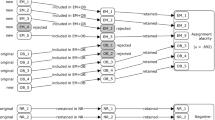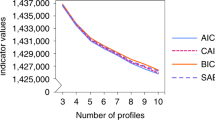Abstract
Some psychometric problems with the Personality Assessment Inventory (PAI) were observed by Boyle and Lennon (1994). However, Morey (1995) asserted there were “several methodological and conceptual limits” and alternative explanations of the Boyle and Lennon data. Although Morey asserted that age and clinical status were confounded, Boyle and Lennon statistically partialled out variance due to age, using ANCOVA procedures. Morey's description of Boyle and Lennon's sample as “unusual” was strange—schizophrenic and alcoholic patients in a psychiatric hospital comprised the clinical groups—the PAI was designed specifically to assess psychopathology in such patients. Although Morey claimed that alpha coefficients were misinterpreted, Boyle and Lennon based their conclusions solely on the obtained coefficients. Morey's attempt to downplay the finding of suboptimal stability for several PAI scales also runs counter to the empirical results actually observed. Finally, Morey attempted to minimize the role of factor analysis in investigating construct validity, apparently to deflect attention from deficiencies in the factor analysis of a clinical sample reported in the PAI manual.
Similar content being viewed by others
References
Block, J. (1995). A contrarian view of the five-factor approach to personality description.Psychological Bulletin, 117, 187–215.
Boyle, G. J. (1979). Delimitation of state-trait curiosity in relation to state anxiety and learning task performance.Australian Journal of Education, 23, 70–82.
Boyle, G. J. (1983). Effects on academic learning of manipulating emotional states and motivational dynamics.British Journal of Educational Psychology, 53, 347–357.
Boyle, G. J. (1985). Self-report measures of depression: Some psychometric consideration.British Journal of Clinical Psychology, 24, 45–59.
Boyle, G. J. (1988). Exploratory factor analytic principles in motivation research. In J. R. Nesselroade & R. B. Cattell (Eds.),Handbook of Multivariate experimental Psychology (pp. 742–745). New York: Plenum.
Boyle, G. J. (1991). Does item homogeneity indicate internal consistency or item redundancy in psychometric scales?Personality and Individual Differences, 12, 291–294.
Boyle, G. J. (1993). Special review: Evaluation of the exploratory factor analysis programs provided in SPSSX and SPSS/PC+.Multivariate Experimental Clinical Research, 10, 129–135.
Boyle, G. J. (1994). Self-Description Questionnaire II. In D. J. Keyser & R. C. Sweetland (Eds.),Test critiques (Vol. 10, pp. 632–643). Kansas City, MO: Test Corporation of America.
Boyle, G. J. (1995a). Measurement of intelligence and personality within the Cattellian psychometric model.Multivariate Experimental Clinical Research, 11, 47–59.
Boyle, G. J. (1995b). Review of the Personality Assessment Inventory. In J. C. Conoley & J. Impara (Eds.),Twelfth mental measurements yearbook, Lincoln, NE: Buros Institute of Mental Measurements.
Boyle, G. J., & Cattell, R. B. (1984). Proof of situational sensitivity of mood states and dynamic traits—ergs and sentiments—to disturbing stimuli.Personality and Individual Differences, 5, 541–548.
Boyle, G. J., & Lennon, T. J. (1994). Examination of the reliability and validity of the Personality Assessment Inventory.Journal of Psychopathology and Behavioral Assessment, 16, 173–187.
Boyle, G. J., & Stanley, G. V. (1986). Application of factor analysis in psychological research: Improvement of simple structure by computer-assisted graphic oblique transformation: A brief note.Multivariate Experimental Clinical Research, 8, 175–182.
Boyle, G. J., Ward, J., & Lennon, T. J. (1994). Personality assessment inventory: A confirmatory factor analysis.Perceptual and Motor Skills, 79, 1441–1442.
Boyle, G. J., Stankov, L., & Cattell, R. B. (1995). Measurement and statistical models in the study of personality and intelligence. In D. H. Saklofske & M. Zeidner (Eds.),International Handbook of Personality and Intelligence. New York: Plenum.
Cattell, R. B. (1973).Personality and mood by questionnaire. San Francisco: Jossey-Bass.
Cattell, R. B. (1978).The scientific use of factor analysis in behavioral and life sciences. New York: Plenum.
Cattell, R. B. (1987).Intelligence: Its structure, growth and action. Amsterdam: North Holland.
Cattell, R. B. (1992). Human motivation objectively, experimentally analyzed.British Journal of Medical Psychology, 65, 237–243.
Cattell, R. B., & Child, D. (1975).Motivation and dynamic structure. London: Academic.
Cattell, R. B., & Kline, P. (1977).The scientific analysis of personality and motivation. New York: Academic.
Author information
Authors and Affiliations
Rights and permissions
About this article
Cite this article
Boyle, G.J. Psychometric limitations of the Personality Assessment Inventory: A reply to Morey's (1995) rejoinder. J Psychopathol Behav Assess 18, 197–203 (1996). https://doi.org/10.1007/BF02229118
Accepted:
Issue Date:
DOI: https://doi.org/10.1007/BF02229118




